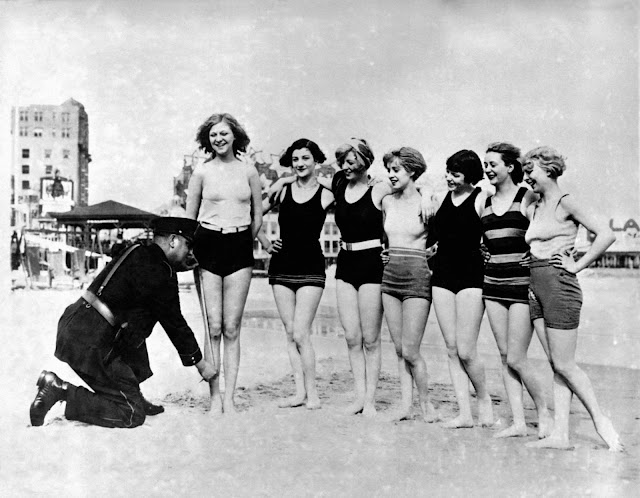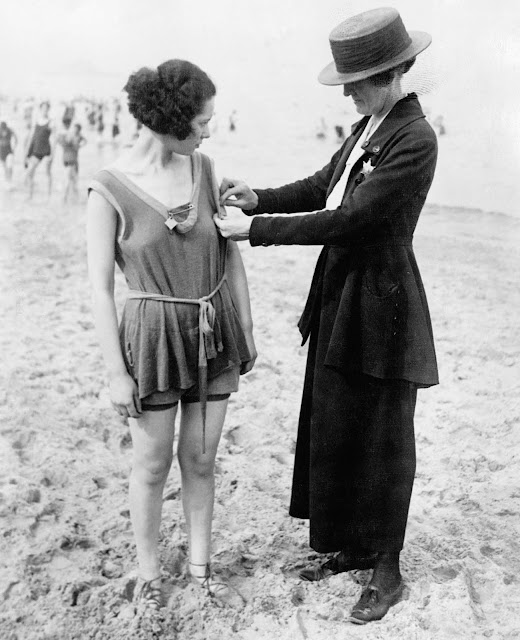Young women in these photographs below are being arrested for exposing their legs in one-piece bathing suits, which was forbidden by ordinances in many U.S. communities in the 1920s. These women were probably either fined or released soon after arrest without charge: few women (or none) served jail time for wearing bathing outfits that violated indecent exposure or "public indecency" laws. Many violators of beach dress codes were fined on the spot by special enforcement officers, "beach censors," rather than being arrested.
Thousands of women were arrested in the 1920s for wearing leg-revealing swimming suits, which were a new development in the history of human clothing. In antiquity, swimming suits did not exist: bathing was done in the nude. However, for most of the last two thousand years open-water bathing or immersion for pleasure essentially did not exist in European societies.
Throughout the nineteenth century, bathing costumes remained bulky and restrictive for women, often made out of flannel or other opaque fabrics and even weighted with lead to keep the skirts from floating upward in the water. "Bathing machines" were standard at seaside resorts in England, essentially closets or booths on wheels that could be rolled down to the water's edge to minimize exposure to the public gaze.
By the 1920s, women's bathing skirts had shortened, in many cases, to just above or below the knee. Further, several forms of gender equality were being sought at the time: the vote, more equitable divorce laws, and broader career choices for women. To some women, it seemed unjust that men should be allowed to wear one-piece bathing suits that exposed their legs to the upper thigh while women must still wear skirts. Crystal Eastman, one of the founders of the American Civil Liberties Union, wrote in 1927 that as early as 1900, as a young girl, she "was a ringleader in the rebellion against skirts and stockings for swimming" in their summer community, and shocked her father by wearing a man's one-piece costume into the water. Yet he allowed her to do so: "he himself had been a swimmer," Eastman wrote, and "he knew he would not want to swim in skirt and stockings. Why then should I?"

|
| In Chicago, a woman is being arrested for defying a Chicago edict banning "abbreviated bathing suits" on beaches, 1922. |
Did You Know: In the 1920s, Police Could Arrest Women for Exposing Their Legs in One Piece Bathing Suits?

|
| Washington policeman Bill Norton measuring the distance between knee and suit at the Tidal Basin bathing beach after Col. Sherrill, Superintendent of Public Buildings and Grounds, issued an order that suits not be over six inches above the knee, 1922. |
Did You Know: In the 1920s, Police Could Arrest Women for Exposing Their Legs in One Piece Bathing Suits?

|
| Women found to be breaking the rules were either asked to leave the beach or made to cover up. |
Did You Know: In the 1920s, Police Could Arrest Women for Exposing Their Legs in One Piece Bathing Suits?

|
| A policeman measuring the swimming costumes of women on the beach in the 1920s. |
Did You Know: In the 1920s, Police Could Arrest Women for Exposing Their Legs in One Piece Bathing Suits?

|
| Two bathers being escorted off the beach by a police woman, Chicago, 1922. |
Did You Know: In the 1920s, Police Could Arrest Women for Exposing Their Legs in One Piece Bathing Suits?

|
| Chicago policewomen checking for violations of the bathing suit-length laws, 1921. |
Did You Know: In the 1920s, Police Could Arrest Women for Exposing Their Legs in One Piece Bathing Suits?

|
| "Smokey" Buchanan from the West Palm Beach police force, measuring the bathing suit of Betty Fringle on Palm Beach, to ensure that it conforms with regulations introduced by the beach censors, 1925. |
Did You Know: In the 1920s, Police Could Arrest Women for Exposing Their Legs in One Piece Bathing Suits?
| Policemen measure a woman in a bathing suit, circa 1920. |
Did You Know: In the 1920s, Police Could Arrest Women for Exposing Their Legs in One Piece Bathing Suits?

|
| California bathers being confronted by policewomen because they were "scantily clad," 1922. |



